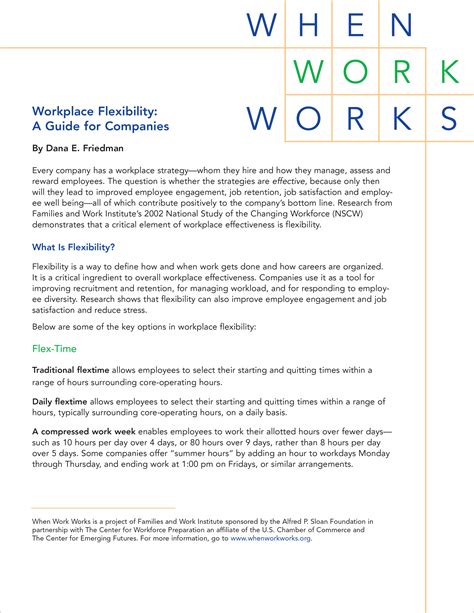Workplace Flexibility: A Comprehensive Guide

Workplace flexibility is essential for creating a healthy and productive work environment. It allows employees to balance their work and personal life, which ultimately leads to increased job satisfaction and better performance. In this comprehensive guide, we will explore everything you need to know about workplace flexibility, including its benefits, types, implementation, and best practices.
Benefits of Workplace Flexibility
Flexibility in the workplace has numerous benefits for both employees and employers. Here are some of the main advantages:
- Improved work-life balance: Workplace flexibility allows employees to have a better balance between their work and personal life, leading to reduced stress, increased happiness, and better mental health.
- Increased job satisfaction: When employees have more control over their work schedule, they feel more empowered and satisfied with their job.
- Better retention rates: Employers who offer flexible work arrangements have higher retention rates, as employees are more likely to stay with a company that values their needs and provides a healthy work-life balance.
- Increased productivity: When employees have the flexibility to work in a way that suits their needs, they are more productive and focused.
- Cost savings: Employers who offer flexible work arrangements can save money on office space, as fewer employees need to be present in the office at all times.
Types of Workplace Flexibility
There are several types of workplace flexibility that employers can offer to their employees. Here are some of the main ones:
Flexible Work Schedule
A flexible work schedule allows employees to work outside of traditional office hours. This can include working from home, working part-time, or working on a compressed schedule (e.g., working four ten-hour days instead of five eight-hour days).
Flexible Location
Flexible location allows employees to work from outside the office, either at home or at another location. This can be especially useful for employees who have long commutes or who need to be closer to home for personal reasons.
Job Sharing
Job sharing involves two employees sharing one full-time job, with each employee working part-time. This allows both employees to have a better work-life balance while still fulfilling the duties of the job.
Leave Options
Leave options include paid time off, sick leave, and personal leave. Employers can offer different types of leave to accommodate different employee needs.
Implementing Workplace Flexibility
Implementing workplace flexibility requires careful planning and communication between employers and employees. Here are some steps to follow:
Assess Your Needs
Before implementing workplace flexibility, it’s important to assess your needs as an employer and the needs of your employees. This can include conducting surveys or focus groups to determine what types of flexibility would be most beneficial.
Create a Policy
Create a policy outlining the types of flexibility you will offer and the guidelines for how they will be implemented. This policy should be communicated clearly to all employees.
Train Your Managers
Managers play a critical role in implementing workplace flexibility. Make sure your managers are trained in how to manage flexible teams and how to communicate effectively with employees who are working outside of the office.
Communicate Regularly
Regular communication is key to ensuring workplace flexibility is successful. Make sure to communicate regularly with your employees to ensure they feel supported and valued.
Best Practices for Workplace Flexibility
Here are some best practices for implementing workplace flexibility:
- Be Flexible: Allow employees to have a say in how they work and what types of flexibility they need.
- Set Clear Expectations: Make sure employees understand what is expected of them and how their performance will be measured.
- Use Technology: Use technology to facilitate communication and collaboration between team members who are working remotely.
- Encourage Face-to-Face Interaction: Encourage employees to come into the office for face-to-face interaction at least once a week.
- Track Performance: Track employee performance to ensure that flexibility is not impacting productivity or quality of work.
Conclusion
Workplace flexibility is essential for creating a healthy and productive work environment. By offering different types of flexibility, such as flexible work schedules, flexible locations, job sharing, and leave options, employers can create a work environment that values their employees’ needs and well-being. Implementing workplace flexibility requires careful planning and communication, but the benefits are well worth it.
FAQs
What are the benefits of workplace flexibility?
Workplace flexibility has numerous benefits for both employees and employers, including improved work-life balance, increased job satisfaction, better retention rates, increased productivity, and cost savings.
What are the types of workplace flexibility?
The types of workplace flexibility include flexible work schedules, flexible locations, job sharing, and leave options.
How can employers implement workplace flexibility?
Employers can implement workplace flexibility by assessing their needs, creating a policy, training their managers, and communicating regularly with their employees.
What are some best practices for workplace flexibility?
Best practices for workplace flexibility include being flexible, setting clear expectations, using technology, encouraging face-to-face interaction, and tracking performance.
